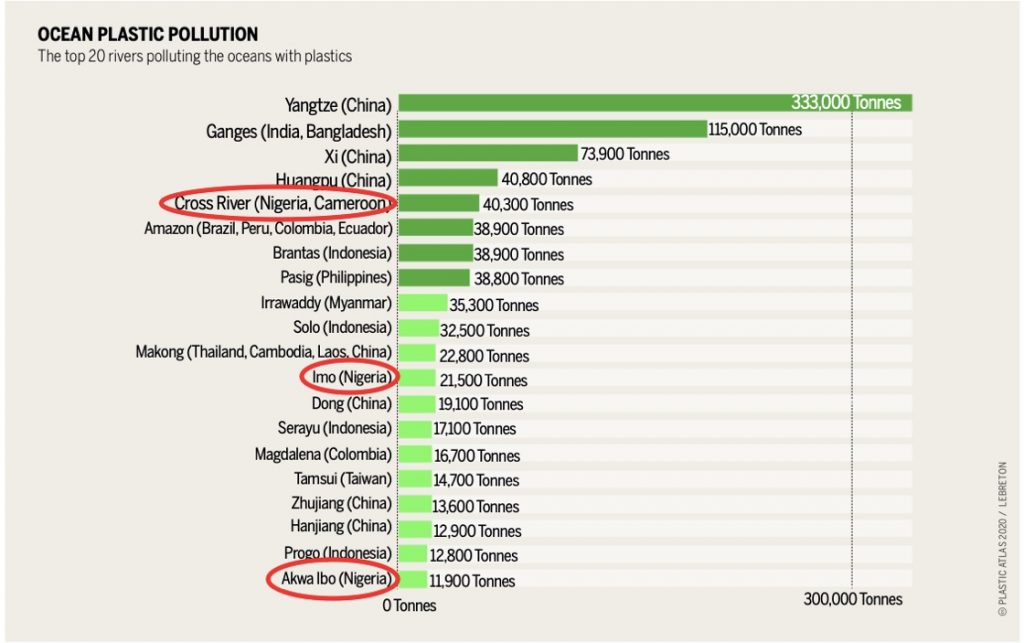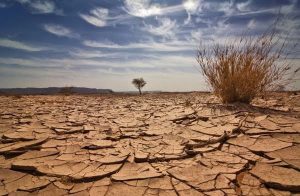There are 20 rivers across the world which hold most of the earth’s aquatic pollutants; three of these are in Nigeria, a new report on mismanaged plastic wastes has revealed.
Cross River between Nigeria and Cameroon takes up to 40,300 tonnes plastics, Imo river, carries 21,500 tonnes while Akwa Ibo discharges 11,900 tonnes into the world’s ocean, the report published by Heinrich Böll Foundation and Break Free From Plastic to show the rising dangers of mismanaged plastic wastes to the environment.
The report equally highlighted that Lagos’ beaches now suffer from great neglect and has a growing build-up of microplastics from tourist activities and poor waste management systems.

On the list, China’s Yangtze, the Ganges shared between India and Bangladesh, as well as the Xi and Huangpu rivers also in China are the top four polluting rivers on earth with a combined discharge of 562,700 tonnes of plastics into the ocean.
Closer Home
Lagos is situated by the Atlantic, the report noted that the impact of microplastic build-up on its beaches may soon be permanent on the state’s leisure and commercial activities.
According to it, the presence of microplastics in the ocean was first reported in 1972, but researches now indicate the presence of microplastics in different compartments of sub-aquatic environments such as biota, water, bottom sediments and beaches.
Nigerian beaches, it noted are no exception to this with discoveries made in Lagos’ Alpha, Oniru, Eleko and Lekki beaches.
Microplastics, the report explained are plastic particles less than five millimetre in any one dimension which fall into primary or secondary categories.
“Plastics intentionally manufactured to be small in size are primary microplastics. They are used in personal care items such as face scrubs and cosmetics, and industrial products such as microfibres in textiles. Secondary microplastics occur when large pieces of plastics such as water bottles, fishing nets and plastic bags break into smaller pieces less than 5mm due to environmental weathering processes,” said the research which informed that 121 to 170 microplastic particles found in 50 grams of dry sediment from Nigerian beaches were largely made up of plastic fragments followed by pellets and fibers.
The fragments, it stated suggest the breakdown of large plastic items into secondary microplastics as the major source of microplastics in the beaches.
Also, the plastic polymers identified in the research on the beaches were polyethylene, polypropylene and polystyrene.
The report added that it is usually difficult to compare the levels of microplastics in different countries due to the lack of standardised methods for sampling and analysis but that similar studies from beaches in Hong Kong, Portugal, Slovenia, Greece, Dubai, Singapore, France, India, and Belgium reported lower levels of microplastics while higher levels were reported in Chinese beaches. China has however responded to the threat posed by microplastics with its proposed ban of single-use plastics by 2021.
Identified Impacts
There are environmental, health and economic impacts of such plastic build-ups; the report explained them to include loss of tourism revenue, distress to aquatic life and human consumption of seafoods containing microplastics.
“In Nigerian beaches, the chief source of microplastics is tourism. Plastic wastes generated by tourists’ activities are poorly managed and subsequently end up in swash zones of the beaches as secondary microplastics. However, plastic litter is also transported by rivers and storm water from inland to the ocean and ends up on shores as microplastics.
“The potential impact of microplastics in the marine environment is the risk of aquatic organisms ingesting them, including species of economic relevance for fisheries and aquaculture, and causing irreparable harm that can threaten marine life and the ecosystem,” it stated.
It further said that this impact on aquatic life can occur in three ways: physical blockage of the feeding system; leakage of plastic additives into their systems and, adsorption or absorption of persistent toxic pollutants from the environment.
For humans, it noted that the risks to public health come from bioaccumulation and transfer of adsorbed pollutants to higher animals.
According to it: “Microplastics are usually restricted to the guts of organisms that consume them, making transfer to humans a rare occurrence since the guts are removed prior to consumption. However, this may not be the case for smaller fishes and other seafood that are consumed whole.
“There is also the potential migration of adsorbed persistent organic pollutants such as polychlorinated biphenyls (PCBs), poly-cyclic aromatic hydrocarbons (PAHs), and organochlorine pesticides such as dichlorodiphenyltrichloroethane (DDT), dieldrin and chlordane to unpolluted areas by the movement of microplastics.”
Besides these negative impacts on the aquatic food chain, the report hinted that tourism, the chief source of plastics on Lagos beaches will be the worst hit.
“No tourist would want to visit a beach that has lost its aesthetic value, invariably reducing commercial activity in this industry,” it added.





